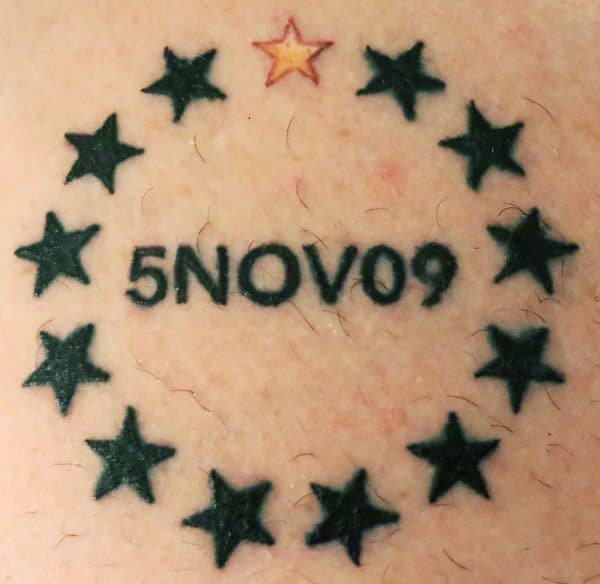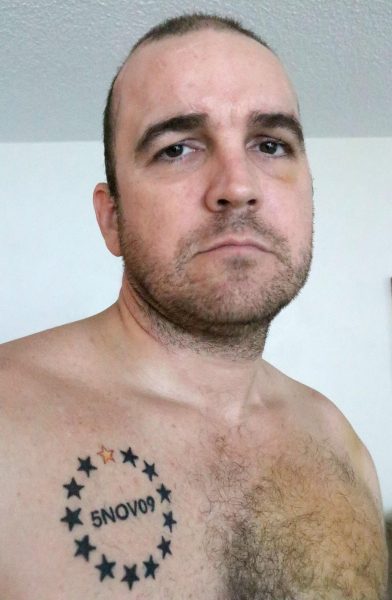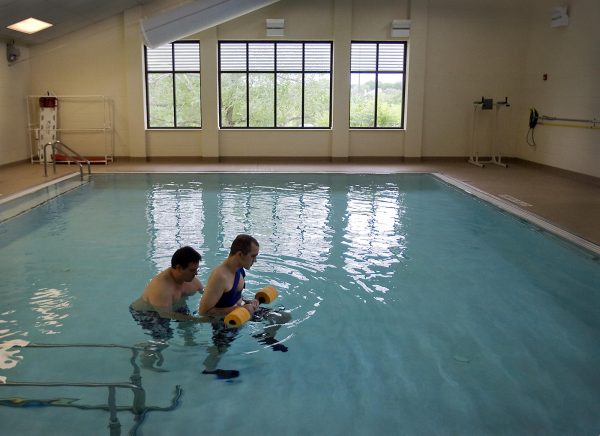On a Friday night in October, Patrick Zeigler lay in a tattoo shop in Daytona Beach. His shirt off and chest bare, he braced as the tattoo gun pierced his skin.
He had mulled the design for several months — the date “5NOV09,” surrounded by a circle of thirteen stars, one for every person killed in the massacre 10 years ago at Fort Hood.
Ziegler timed the appointment just so, to give the tattoo enough time to heal before the 10th anniversary of the shooting Tuesday, Nov. 5.
He asked that one of the stars be made gold, in honor of all the other lives that were torn apart that day, among them, his own.

Patrick Zeigler’s tattoo, which he got in Daytona Beach, shows 13 stars. Each star represents those who were killed in the 2009 mass shooting at Fort Hood, Texas. [News-Journal/David Tucker]
A former Army staff sergeant who served two tours in Iraq, Zeigler was one of more than 30 who were injured in the mass shooting in 2009, which was carried out by a former Army psychiatrist and Islamic extremist in the Soldier Readiness Processing Center of the post in Killeen, a military town north of Austin.
Continue the discussion about local government and elected officials in the News-Journal’s Volusia Politics Facebook group.Of those who survived, Zeigler’s injuries were among the most serious. A bullet that penetrated his skull caused him to lose 20% of his brain.
Now, the 38-year-old still relies on a cane to walk some days. His left hand is limp and mostly unusable. Because the bullet struck in the right hemisphere, the left side of his body remains slow to heal. Wounds on those limbs often turn to open sores that linger for weeks.
Zeigler said he usually wears some kind of military attire, an Army hat or T-shirt, so that when people notice his injuries they don’t ask any questions. They assume he was hurt in the war.

Patrick Zeigler with a tattoo for those killed in the 2009 mass shooting at Fort Hood Texas, Thursday October 24, 2019 in his Daytona Beach Shores home, Zeigler was a Staff Sergeant in the US Army at Fort Hood Texas and was shot four times in the head during the 2009 mass shooting. [News-Journal/David Tucker]
Yet, despite serving in combat during the bloodiest time in the Iraq War in 2007, it was back home, on American soil, that Zeigler sustained his traumatic injuries.
“I have irritability and frustration beyond measure. That’s mostly just due to my disabilities,” he told the American-Statesman, speaking candidly about his recovery. “But the anger, the deeper anger that’s involved with all of it is still there below the surface. It’s something that I’ve had to struggle with.”
Today, Zeigler lives in a 1,900-square-foot apartment on the beach in Daytona Beach Shores, just a mile from his grandmother’s home. He said the ocean has been healing. From his window, he can see the ice blue water and hear the waves lap hypnotically against the shore.
“Some days, I power walk on the beach. And I can do the elliptical machine and kind of keep the weight off if I’m smart about food and stuff,” Zeigler said. “There’s definitely ways around the impairments that I’ve faced. You just make disabilities into abilities. That’s the key for me.”
A massacre
When paramedics found Zeigler, he was lying on the ground outside the Soldier Readiness Processing Center behind a trail of his own blood. Believing he would die, they secured a black tag around his toe. It wasn’t until Zeigler started screaming that a medic rushed him to an ambulance, then to a hospital in nearby Temple.
Zeigler had sustained a gunshot wound to his right temporal lobe, as well as three others to his shoulder, arm and hip. Doctors said at the time that he had a 1 in 10 chance of surviving.
Maj. Nidal Hasan, the shooter, had fired 241 rounds in 10 minutes, killing 12 soldiers and one civilian employee and injuring more than 30 others before two Fort Hood civilian police officers were able to bring him down with gunfire.
Those who survived, including many who had survived combat, said the scene mirrored a war zone.

Staff Sgt. Patrick Zeigler, who was wounded in the Nov. 5, 2009, shooting at Fort Hood works on his rehabilitation at the Texas NeuroRehab Center in Southwest Austin in 2010. Zeigler had nine brain surgeries and had to relearn to walk three times. After each surgery, his leg muscles would atrophy and he would forfeit all the progress he had made. [Ralph Barrera/American-Statesman]
For Zeigler, the day had started like any other. He woke early and went to physical training and morning formation, then made his way to the center to complete paperwork that was required of all soldiers who return from overseas. Zeigler had only returned to the U.S. from Iraq 12 days earlier, leaving ahead of the rest of his unit to attend Officer Candidate School, a lifelong dream.
At lunch, he had Hawaiian barbecue. After, he sat in his car for about an hour and smoked a cigarette.
Zeigler recalled that he almost went home then but decided instead to finish the last things on his list that day: a visit to a psychologist and checking to make sure his vaccinations were up to date.
He entered the center, a giant room with only a few scattered cubicles, and sat in the second row of chairs. Around him, people milled about and chatted with one another — most bored from a long day doing paperwork.
At 1:34 p.m., a man armed with a semi-automatic pistol stood up and shouted, “Allahu Akbar!”
“I knew what the words meant,” Zeigler said, remembering the moment his eyes fixed on Hasan’s. Faced with the reflex to fight or flee, he froze.
“I didn’t realize what the hell was happening,” Zeigler said. “Then he turned around 180 degrees and started shooting.”
Zeigler saw the red laser that fixed on his face, then felt the sensation of metal striking his head. His ears rung as the bullet broke through bone and shattered into tiny pieces. The force was so strong it knocked him out of his chair. Panicked, he crawled to escape. But as he struggled to catch his breath, he lost consciousness. He woke to Hasan standing over him and firing three more times.
“It’s almost like a stereotypical thing where he just looked really, you know, pissed off at the world. There was just rage on his face,” Zeigler said. “He had been working up to that point for years. So, he was really focused. And so was I, honestly, in the first hours afterwards. I just tried to stay awake because I knew going to sleep would be the worst thing.”
Zeigler was afraid if he closed his eyes he might never wake up.
Road to recovery
The first year was touch and go.
Doctors tried continually to cover the hole in Zeigler’s skull to protect his brain. In total, he had nine brain surgeries and had to relearn to walk three times. After each surgery, his leg muscles would atrophy and he would forfeit all the progress he had made.
His then-girlfriend, eventual wife and now ex-wife, Jessica Hansen, stood by him. The outpouring of support he received from fellow veterans and strangers was so great that, still today, Zeigler counts it among his biggest blessings.
The Statesman previously chronicled Zeigler’s recovery in a story published in 2010. He has made numerous strides since then. After doing outpatient rehab, he was able to walk without a cane. Doctors cut him down from eight medications a day to three. And he started doing group therapy to deal with the emotional fallout of the shooting. Despite suffering with chronic pain, he lives a relatively normal life today.
“My PTSD is mild compared to a lot of people’s,” Zeigler said. “I credit that to my upbringing. Growing up in a military family, I was just a little bit stronger-minded, I guess, stronger-willed.”
Zeigler was raised on military bases. His father was a Navy recruit division commander, the equivalent of a drill sergeant. Zeigler always had aspirations to fight overseas. After graduating from Florida State University, he said he was drinking heavily and had lost his sense of direction. The year was 2005, and there were two wars going on at the time. Zeigler decided to join the Army.
“I wanted to do something extraordinary,” he said. “I wanted to be a tool of the U.S. government and I just wanted to lead soldiers, you know, during a battle or during a conflict. And it turns out I did, but not in the same way that I expected.”
Zeigler was a scout with the 6th Squadron, 9th Cavalry Regiment of the 1st Cavalry Division, which was stationed in Iraq’s Diyala River Valley during the war. They engaged in firefights and dodged roadside bombs. On Memorial Day 2007, one exploded, killing six in Zeigler’s troop.
“I actually was thinking more of dying than getting hurt like this,” Zeigler said, thinking back on his time in combat. “You don’t really think about having a long-term health issue. For me, it was just more I signed up for a pretty dangerous job. I wasn’t apathetic, but I was … just, you know, expecting to not make it through the first year, I guess.”
Ziegler did make it through that first year, though, and more than that, he fell in love with the Army. He decided he wanted to be a commissioned officer and command a unit of soldiers.
It was one of many dreams stolen from him the day of the shooting.
In 2011, Zeigler was forced to retire from the Army.
“That’s when they started telling me about the new normal. ‘You gotta accept this new normal. You’re not going to be a soldier,'” he said.
Zeigler did not take it lightly. For many years, he battled depression, which reached its lowest point after the birth of his son, Liam, in 2012.
“I didn’t know how to adapt to being a paralyzed, handicapped father,” Zeigler said. “I couldn’t do anything. I couldn’t change a diaper. My one big task that I accomplished a lot was taking out the trash after my ex had tied it up and gotten it ready to go and then I would take it outside.”
Liam was a colicky baby. Twice, Zeigler ended up in psych wards when he couldn’t take the sound of his crying any longer.
He and Jessica had moved to Minnesota to be closer to her family. The bitter cold and long winters were hard on his psyche. The two fought often, and his drinking took on a destructive nature. It seemed, for a time, that the life Zeigler had fought so valiantly to hold onto was slipping away.
Then, as quickly as a heavy fog rolls in, the darkness lifted.
“I just had kind of a moment of clarity, like, ‘Why would I take my life that was given to me and waste it like this?'” Zeigler said. “I decided to get up off my ass, out of bed and start doing as much as I could to stay busy and keep my mind and body occupied.”
Zeigler moved back to Florida, where he grew up, to be closer to the beach and the healing warmth of the sun. He helped other veterans through volunteering and traveled around the world. In 2018, he and Jessica divorced. However, they remain on good terms and share custody of Liam, who visits Zeigler several times a year.
“Thank God, I didn’t listen to doctors who said I wasn’t going do anything,” Zeigler said. “That’s pretty common in people with traumatic injuries, where they just don’t accept the situation.”
Finding forgiveness
The second time Zeigler faced Hasan was in a courtroom at Fort Hood in 2013, during Hasan’s death penalty trial.
One by one, victims and their family members took to the stand to share how their lives had been decimated by Hasan’s actions. Zeigler said he prepared mentally and physically for that day, perfecting his gait so he could walk without a cane to the witness stand.
During his testimony, he looked at Hasan only once.
Zeigler spoke about his injuries and the challenges of caring for his son.
At the conclusion, Hasan, who admitted to carrying out the shooting to defend the lives of Taliban leadership in Afghanistan, was convicted of 13 counts of premeditated murder and sentenced to death. His conviction is under appeal and he remains on death row. An execution date has not been set.
Zeigler said he has since forgiven Hasan — a decision he made after Liam was born — because he couldn’t live with the anger any longer.
“I knew from experience that if I held the grudge against him or thought about him all the time, I’d be giving him the power and I could just be Christian and forgive him,” Zeigler said. “He was just a soldier, and he thought he was doing the right thing. And I know I can relate to that. You know, I didn’t go killing a bunch of innocent people in Iraq, but I can totally understand that he felt like it was his duty. So, I forgave him.”
Zeigler doesn’t define himself as a victim or a survivor. In his eyes, he is, first and always, a soldier. Unfortunately, he said his military service is often overshadowed by the tragedy of that day. But as he sat down to write a book last year about his life, it was his memories in combat, not necessarily of the shooting, that rose to the forefront.
“I don’t think that Fort Hood should ever be the only thing that ever defines you,” he said. “I went to war for two years.”
Zeigler said he expects to release the book next year. He plans to give whatever money he earns from sales to veteran nonprofits, including the Florida-based 22 Project, which helps soldiers recover from traumatic brain injuries and PTSD with hyperbaric oxygen therapy, which uses air pressure to increase oxygen flow through the body. Zeigler said the treatment has helped him remarkably and that even his brain scans are showing improvement.
Today, he tries to focus on living. Going to the beach. Traveling. Spending time with his son.
“There’ll be plenty more hospital time in my life and tubes and tests and all that good stuff,” he said. “I just want to enjoy my life.”
In Killeen, about 5 miles southeast of Fort Hood, a memorial was erected with bronze sculptures honoring each of the 13 victims. A public memorial will be held there Tuesday, with a bugler and color guard and Army officials in attendance.
Seven thousand miles away, Zeigler will sink his head, which is marked on the right side with a giant scar, into the River Jordan during a guided tour through Israel, timed to the anniversary. Zeigler said the trip is a chance for renewal.
“I haven’t been always the nicest and the most Christian person,” he said. “I think that it’ll be a really good thing going forward for the next year or two.”
Asked whether he’s still angry about being shot, Zeigler said no.
“I feel I kind of took one for the team,” he said. “Hopefully, I saved somebody (else’s) life.”
___
© 2019 The News-Journal
Distributed by Tribune Content Agency, LLC.



